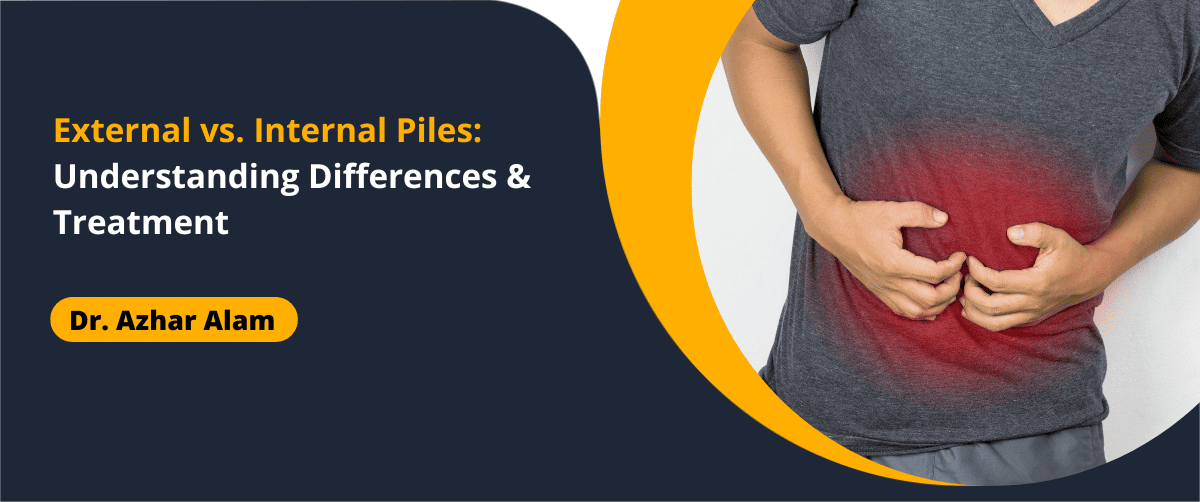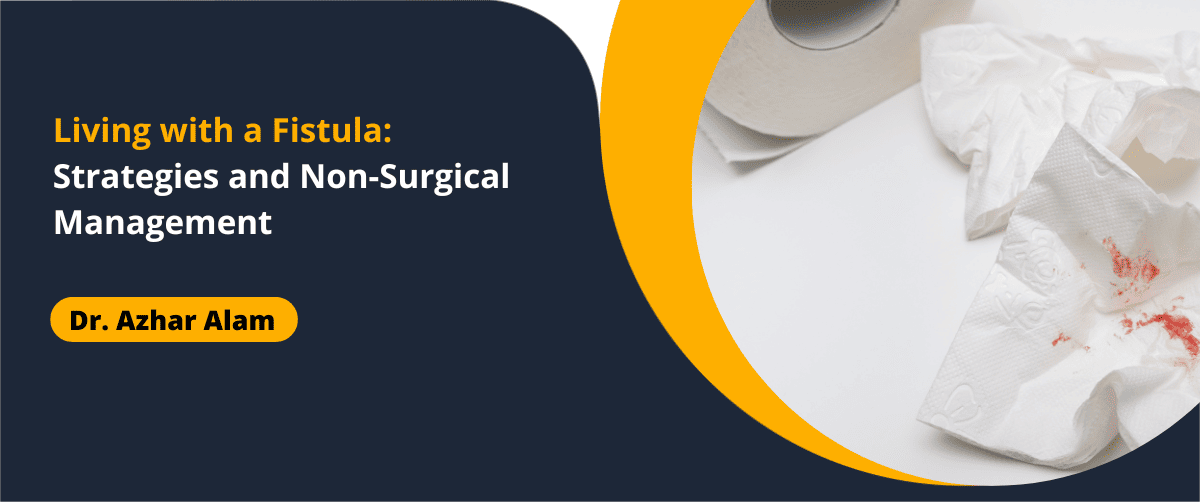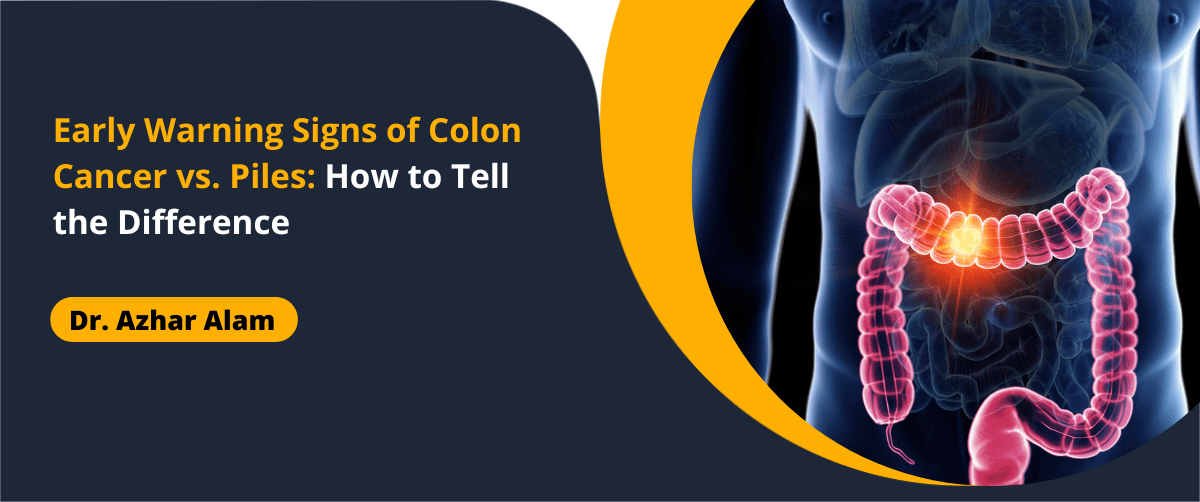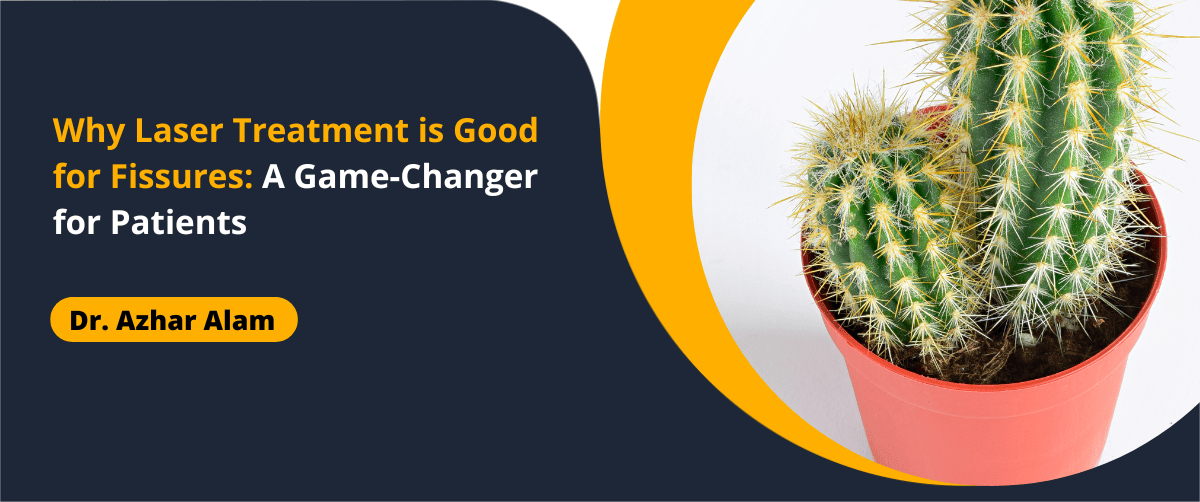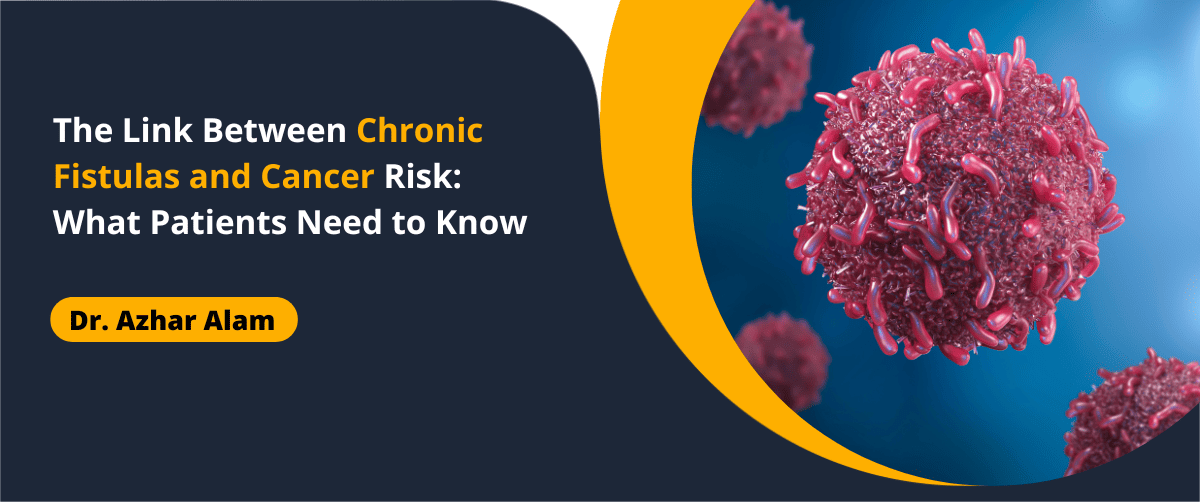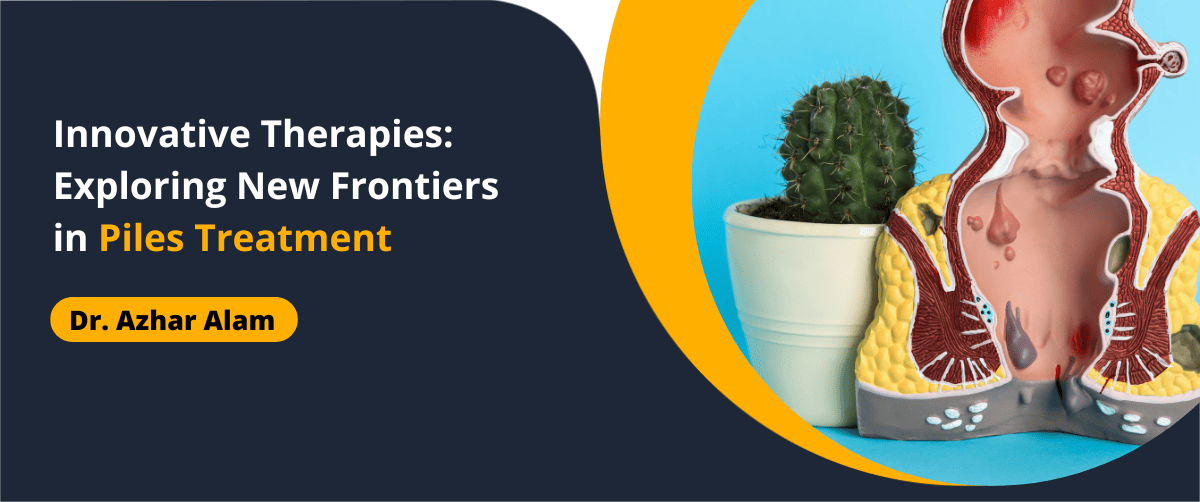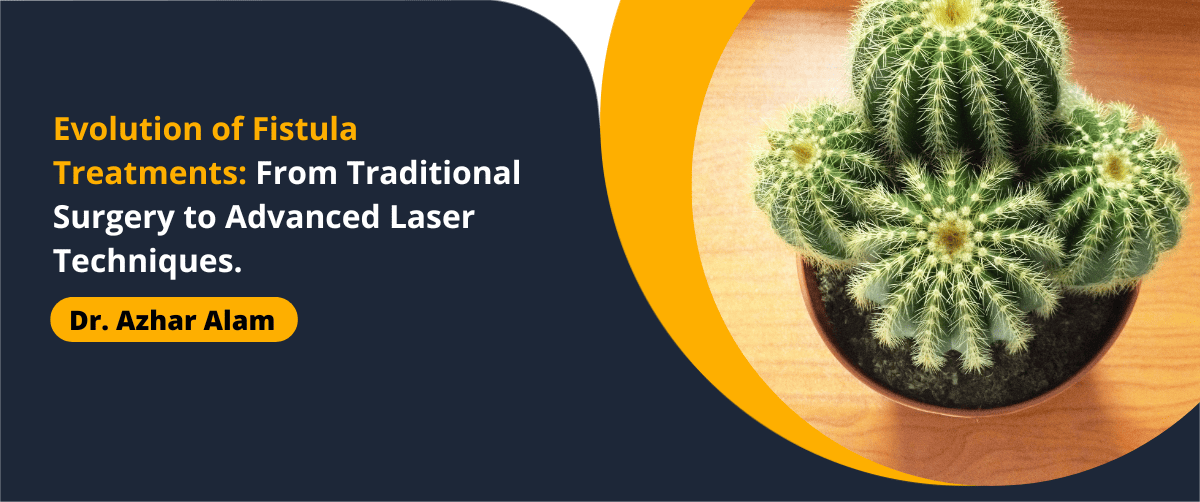External vs. Internal Piles
Piles, or hemorrhoids, are a prevalent condition that can cause significant discomfort, yet many patients are confused about the differences between external vs internal piles. These two types of hemorrhoids vary in their location, symptoms, and treatment approaches, making it essential to understand their distinctions for effective management. Whether you’re dealing with painful swelling or painless bleeding, knowing which type you have can guide you toward the right care. In Kolkata, Dr. Azhar Alam, a leading piles specialist, offers precise diagnostics and advanced treatments, including piles laser treatment in Kolkata, to address both external and internal piles. This comprehensive guide explores the differences between external vs internal piles, how they’re diagnosed, available treatment options, and how Dr. Alam’s expertise ensures lasting relief.
What Are Piles?
Piles are swollen veins in or around the anus and rectum, caused by increased pressure from factors like constipation, prolonged sitting, or obesity. They’re classified into two types based on their location relative to the dentate line (a boundary in the anal canal):
- Internal Piles: Located inside the rectum, above the dentate line, where there are fewer pain-sensing nerves.
- External Piles: Found under the skin around the anus, below the dentate line, where pain receptors are abundant.
Understanding these distinctions is crucial, as symptoms and treatments vary significantly, affecting how patients manage their condition.
More Link: Early Warning Signs of Colon Cancer vs. Piles
Differences Between External and Internal Piles
To clarify the unique characteristics of each type, here’s a detailed comparison of external vs internal piles, including symptoms, causes, and complications.
- Location
- External Piles: Form outside the anus, under the skin, and are visible or palpable as small, tender lumps.
- Internal Piles: Develop inside the rectum, invisible from the outside unless they prolapse (protrude) through the anus.
- Symptoms
- External Piles:
- Pain: Often painful, especially during bowel movements, sitting, or cleaning, due to sensitive nerve endings.
- Swelling: Noticeable lumps or swelling around the anus, which may feel tender or hard if thrombosed (clotted).
- Itching: Irritation from skin rubbing or mucus leakage.
- Bleeding: Less common but possible if the skin breaks.
- Internal Piles:
- Bleeding: Painless bright red blood during bowel movements, often seen on toilet paper or in the bowl.
- Prolapse: Advanced internal piles (Grade III–IV) may protrude during bowel movements, sometimes requiring manual repositioning or becoming irreducible.
- Discomfort: Minimal pain unless prolapsed; may cause a feeling of fullness or incomplete evacuation.
- Mucus Discharge: Can cause itching or irritation around the anus.
- External Piles:
- CausesBoth types share common triggers, but their location influences severity:
- External Piles: Often linked to acute straining (e.g., during constipation or heavy lifting), prolonged sitting, or obesity, which increase pressure on external veins.
- Internal Piles: Frequently caused by chronic constipation, diarrhea, or increased intra-abdominal pressure (e.g., from pregnancy or obesity), stressing internal rectal veins.
- Complications
- External Piles: Thrombosis (blood clots) can form, causing severe pain and requiring urgent treatment. Chronic irritation may lead to skin tags.
- Internal Piles: Prolapse can become irreducible (Grade IV), leading to strangulation, pain, or infection. Chronic bleeding may cause anemia in rare cases.
Comparison Table: External vs. Internal Piles
| Feature | External Piles | Internal Piles |
|---|---|---|
| Location | Under skin around anus | Inside rectum |
| Pain | Common, especially when sitting or moving | Rare unless prolapsed |
| Bleeding | Less common, only if skin breaks | Common, painless bright red blood |
| Visibility | Visible as lumps | Invisible unless prolapsed |
| Itching | Frequent due to irritation | Possible from mucus discharge |
| Complications | Thrombosis, skin tags | Prolapse, strangulation, anemia |
| Common Triggers | Straining, sitting, obesity | Constipation, pregnancy, diarrhea |
This table highlights why accurate diagnosis is critical, as treatment plans differ based on the type and severity of piles.
Diagnosing External and Internal Piles
Proper diagnosis ensures the right treatment, as external and internal piles require distinct approaches. Dr. Azhar Alam uses advanced, patient-friendly methods to assess pile types in Kolkata:
- Medical History: Dr. Alam reviews symptoms (e.g., pain vs. bleeding), bowel habits, and risk factors like constipation, obesity, or pregnancy to determine the likely type.
- Physical Examination:
- External Piles: Visual inspection and gentle palpation identify visible lumps or thrombosis.
- Internal Piles: A digital rectal exam (DRE) detects abnormalities, though prolapsed piles may be visible externally.
- Anoscopy or Proctoscopy: A small, lubricated scope examines the anal canal and rectum, confirming internal piles’ size, grade (I–IV), and prolapse status.
- Sigmoidoscopy (if Needed): For persistent bleeding or suspected underlying conditions (e.g., Crohn’s disease), a flexible scope evaluates the lower colon.
Dr. Alam’s empathetic approach ensures comfort during these sensitive exams, using sedation or anesthesia when needed for anxious patients. His precise diagnostics guide tailored treatment plans, addressing both symptoms and root causes.
Treatment Options for External and Internal Piles
Treatment varies by pile type, severity, and patient needs. Below are the most effective options, with a focus on non-surgical and surgical approaches, including Dr. Alam’s expertise in internal hemorrhoids treatment.
- Non-Surgical Treatments
- Best for External Piles: Mild to moderate cases or thrombosed piles in early stages.
- Best for Internal Piles: Grade I–II piles with minimal prolapse.
- Options:
- Sitz Baths: Soak the anal area in warm water (10–15 minutes, 2–3 times daily) to reduce swelling, pain, and itching. Highly effective for external piles’ discomfort.
- High-Fiber Diet: Consume 25–30 grams of fiber daily (e.g., oats, fruits, vegetables) with 8–10 glasses of water to soften stools, reducing straining for both types.
- Topical Treatments: Over-the-counter creams (e.g., hydrocortisone, lidocaine) relieve external piles’ pain and itching; less effective for internal piles.
- Medications: Laxatives or fiber supplements (e.g., psyllium husk) ease constipation; pain relievers for external piles’ acute discomfort.
- Rubber Band Ligation: For Grade II–III internal piles, a small band is placed around the hemorrhoid base to cut off blood supply, causing it to shrink (outpatient procedure).
- Benefits: Non-invasive, supports symptom relief, and prevents worsening.
- Limitations: May not resolve severe or prolapsed piles, especially Grade III–IV internal piles.
- Minimally Invasive Laser Surgery
- Best for External Piles: Thrombosed or chronic cases unresponsive to non-surgical care.
- Best for Internal Piles: Grade III–IV piles with prolapse or persistent bleeding.
- How It Works: A precise laser beam targets hemorrhoidal tissue, shrinking or removing it while sealing blood vessels to minimize bleeding. Performed under local or general anesthesia.
- Benefits:
- Minimal Pain: Less invasive than traditional hemorrhoidectomy, with smaller incisions.
- Quick Recovery: Most patients resume normal activities within 3–5 days.
- Low Recurrence: Addresses the root cause, reducing future flare-ups.
- Versatile: Effective for both external and internal piles, especially complex cases.
- Pro Tip: Piles laser treatment Kolkata is ideal for patients seeking minimal downtime.
- Traditional Surgery (Hemorrhoidectomy)
- Best for: Severe external piles with large thrombosis or Grade IV internal piles with irreducible prolapse.
- How It Works: Surgical removal of hemorrhoids under general anesthesia, often requiring stitches.
- Benefits: Definitive solution for advanced cases.
- Limitations: More painful, with longer recovery (2–4 weeks) and higher risk of complications like incontinence.
- Lifestyle Modifications
- Best for: Both types, to prevent recurrence post-treatment.
- Options:
- Weight Management: Lose 5–10% of body weight if overweight to reduce pelvic pressure.
- Exercise: Engage in low-impact activities (e.g., walking, yoga) to improve circulation and prevent constipation.
- Avoid Straining: Limit prolonged sitting or heavy lifting; use a cushion for comfort.
- Benefits: Enhances treatment outcomes and reduces future risk.
Anonymized Patient Story: A 45-year-old Kolkata teacher experienced painful external piles, mistaking them for internal due to bleeding. Dr. Azhar Alam’s anoscopy confirmed thrombosed external piles, treated with laser surgery. Paired with a high-fiber diet, the patient was symptom-free within a week, praising Dr. Alam’s clear explanations and swift care.
Dr. Azhar Alam’s Expertise: Comprehensive Care in Kolkata
For patients in Kolkata seeking piles laser treatment Kolkata, Dr. Azhar Alam offers a trusted, patient-centered approach to manage both external and internal piles:
- Advanced Diagnostics: Using anoscopy, proctoscopy, and sigmoidoscopy, Dr. Alam accurately identifies pile type and severity, ensuring tailored treatment.
- Laser Surgery Specialization: His expertise in minimally invasive laser treatment delivers effective relief with minimal pain and downtime, ideal for both pile types.
- Holistic Guidance: Dr. Alam provides personalized lifestyle advice, including diet and exercise plans, to prevent recurrence and support overall health.
- Empathetic Care: His discreet, compassionate consultations ease patient anxiety, addressing sensitive symptoms with professionalism.
Piles treatment in Kolkata is elevated by Dr. Alam’s commitment to combining cutting-edge technology with comprehensive care, making his clinic a go-to for those navigating external vs internal piles.
FAQs About External and Internal Piles
What’s the main difference between external and internal piles?
External piles are outside the anus, often painful and visible, while internal piles are inside the rectum, typically painless but cause bleeding or prolapse.
How can I tell if I have internal or external piles?
Painful lumps or swelling suggest external piles; painless bleeding or prolapse indicates internal piles. Consult a specialist like Dr. Azhar Alam for accurate diagnosis.
Can external piles be treated without surgery?
Mild external piles often respond to sitz baths, topical creams, and a high-fiber diet, but severe or thrombosed cases may require piles laser treatment in Kolkata.
Is laser surgery effective for internal piles?
Yes, laser surgery is highly effective for internal hemorrhoids treatment, especially Grade III–IV, offering minimal pain and quick recovery.
How can I prevent piles from recurring?
Adopt a high-fiber diet, stay active, manage weight, and avoid straining. Regular check-ups with Dr. Azhar Alam can catch issues early.
Call to Action: Get Clarity and Relief with Expert Care
Understanding the differences between external vs internal piles is the first step toward effective treatment. Whether you’re dealing with painful external lumps or bleeding internal piles, Dr. Azhar Alam, a leading piles doctor in Kolkata, offers advanced piles laser treatment in Kolkata and personalized care to restore your comfort. Don’t let confusion or discomfort linger—seek expert guidance today.
Schedule a consultation with the piles doctor in Kolkata, Dr. Azhar Alam to diagnose and treat your piles with precision and compassion. Take control of your health and enjoy lasting relief.
